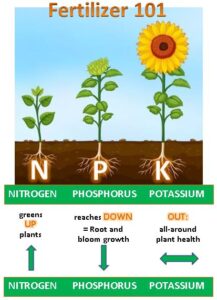For most of us, the summer heat is something we looked forward to back in early February. But now that it’s here we often wish for a reprieve from the outdoor baking. Lawns that looked green, thick and lush a few short weeks ago are now brown, dry, patchy and thin. When the summer heat is combined with a scarcity of rain we enter into a period of drought. Drought is hard on our trees, shrubs, flowers, vegetable crops, perennials – and especially our lawns. So even if a summer drought is inevitable, brown patches in your lawn and permanent lawn damage does not have to be. Here are the most common questions (along with their answers) we get here at Tim Wallace Landscape Supply regarding summertime lawn care.
How do I keep my grass green year round?
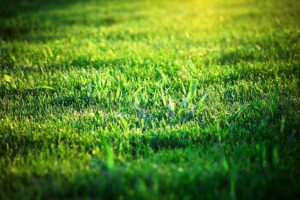
Short answer: You need to use a good quality fertilizer. Apply it several times over the entire course of the growing season and – water, water, water. (There’s a lot more we could look at, but we’ll address that in a separate post.)
Is it OK if my grass turns brown (goes dormant)?
According to the Purdue University News Service, the answer is “yes” since most Illinois turf species are relatively drought tolerant.” (Considering the alternative is watering every other day or so – which can be very expensive and in many communities, not allowed.) Purdue Extension turfgrass specialist professor Aaron Patton explains: “In order to keep your lawn green during hot and dry periods, at least 1 inch of water will need to be applied weekly,” Patton said.
“However, you can keep your lawn alive with far less water. That is why we advise to water once every two weeks with one-half inch of water once the turf goes dormant to keep plant crowns hydrated during drought. This amount of water will not green up the turf, but it will increase long-term survival during long dry spells. Once the lawn turns brown and goes dormant, we can’t tell if a lawn is dying unless we water and wait to see the response.”
But why take the chance? Follow Patton’s advice and give your lawn that ½ inch of water at least every 14 days if it hasn’t rained.
Patton further emphasizes that when lawns are dry, it is important to stay off them as much as possible. Mowers and other heavy equipment can cause substantial damage to vulnerable, stressed grass. Once rains return, the turf will begin to recover and grow new leaves within two weeks.
How much and how often should I water during drought conditions?
The preferred approach is to water your lawn infrequently – in other words, let your lawn become dormant during a drought, this, according to climatologist Laura Edwards. If your grass has turned brown, it’s dormant. Just remember, dormancy is not a death sentence. The plant is still alive, but the leaves dry up and die. This defense mechanism helps the plant conserve water and survive a drought, says Professor Patton.
“Water once every two weeks with one-half inch of water once the turf goes dormant to keep plant crowns hydrated during drought,” advises Patton. “This amount of water will not green up the turf, but it will increase long-term survival during long dry spells.”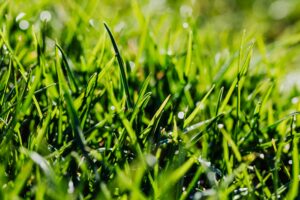
A resilient lawn should be able to go dormant in the summer without much harm. Unless an extreme drought hits, your lawn should be able to bounce back without much water. Just keep in mind that if there’s no rain and you do no watering for 2 weeks or more, you could lose your entire yard.
What should I do after the drought ends?
When the drought is over, the most important thing you can do is re-introduce water to your lawn. By definition, a drought breaks when it rains, so your lawn’s first watering after a drought will be of the natural variety. But once you return to watering your lawn, it is important to water correctly. Watering deeply (1 inch) and less frequently forces roots to grow deep and reach as much water as possible. Avoid shallow watering (less than ½ inch) because it causes roots to spread out just beneath the soil and results in weaker turf.
Can I fertilize my lawn during a drought?![]()
Wait for rain before you introduce fertilizer onto your lawn. However, it is ok to spot spray weeds (our recommended method) during times of drought. When the grass is dormant during drought, it will not absorb the nutrients from the fertilizer, which is harmful to the environment and a waste of time and money. It is better to fertilize your plants before the dry season begins. If your plants are already distressed because of drought, postpone it to a later time. Fertilizers that are applied in the summer should also be low-nitrogen fertilizers that reintroduce nutrients into the soil so the lawn can maintain healthy growth throughout the summer months. Whereas nitrogen-rich fertilizers are appropriate for the early springtime green-up and growth, they can cause further stress to lawns in the summer and even cause burns. That’s why low-nitrogen fertilizer is your best option for summer lawns.
Should I be mowing my lawn short or longer during a period of drought?
During the warmest summer months – raise your mower blade.
Bob Mann, corporate agronomist for regional lawn care company Lawn Dawg and member of the National Association of Landscape Professionals sees a well-maintained lawn as a canvas upon which a beautiful home landscape is built.
“You want to make sure you’re utilizing every bit of the water that’s in the soil,” Mann explains. “Keeping grass cut at a height of three to four inches will create a deeper root system that will pull more water from deep in the soil. In addition to that, you have the shading effect. Longer grass will keep the soil cooler and that means you’re not going to use as much water. To keep your lawn as healthy as possible during a drought,” concludes Mann, “longer is better.” Raising mowing heights creates a deeper and more extensive root system, allowing plants to withstand summer stress. Plus, that taller grass will allow soil temperatures to remain cooler at the soil surface.
How can I repair or improve my lawn after a summer drought?
Our recommendation for Spring or early Fall lawn improvement uses a 4 step approach:
1: Core Aeration
2: Overseed with quality grass seed
3: Top-dress the lawn with our Lawn Repair Mix
4: Water regularly
Step 1: Core aeration
A dry and hot summer causes grass roots to become stressed from trying to maintain moisture and nutrients. During the extreme dryness of summer, the soil becomes extremely compacted and cracks in many areas.
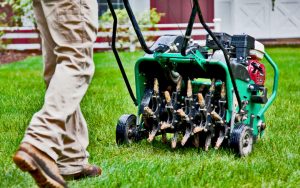 In these conditions, many lawns go dormant and brown out. A prolonged drought brings a myriad of additional issues to lawns as well. Undesirable warm season grasses, insects, and diseases take a gambit throughout, leaving patchy, matted, and thinned-out turf.
In these conditions, many lawns go dormant and brown out. A prolonged drought brings a myriad of additional issues to lawns as well. Undesirable warm season grasses, insects, and diseases take a gambit throughout, leaving patchy, matted, and thinned-out turf.
Core aeration is a mechanical process, which extracts cores – or plugs of soil, thatch and grass from the surface of the lawn to increase nutrient availability, increases water penetration, soil air exchange and reduces compaction. But before you aerate, go ahead and mow your lawn, maybe a bit shorter than normal. Rock hard soil is not aeration friendly, so be sure to wait until after a rain or water your lawn the day before you aerate to soften and loosen the soil.
Four benefits of core aeration:
- Aeration reduces soil compaction. Just as you wouldn’t try to plant a flower in concrete… rock hard soil is not conducive to a great lawn. Loose soil allows grass roots to work deeper into the soil to find vital water resources in times of stress.
- Aeration reduces thatch. Thatch is made up of grass stems and roots that accumulate faster than they breakdown. Excessive thatch creates an environment that is favorable to pests and disease. They also reduce fertilizer take-up to your lawn grass.
- Aeration allows access to the root zone. By penetrating the soil, you’re allowing moisture, air, & food to the root zone where nutrients are absorbed.
- Aeration enhances seed germination. Seeds germinate easily in aerator holes as the holes provide them a place to be in contact with soil where they can germinate and grow.
Step 2: Overseeding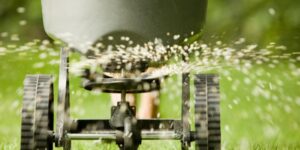
Overseeding is the planting of grass seed directly into an existing lawn, without tearing up the turf, or the soil. It’s an easy way to fill in bare spots, improve the density of your lawn, establish improved grass varieties and enhance your lawn’s color.
Four benefits of overseeding:
- Overseeding introduces new grass seed to fill in bare or thin areas as well as thickens existing lawns. Over time, grass plants reach their peak maturity and need to be replaced. Different factors contribute to the breakdown of your grass including foot traffic, heat, lack of water, mowing factors, environmental conditions, pet waste, etc.
- Overseeding builds resistance to disease.By incorporating different blends of grass seed, you reduce your risk to diseases that can wipe out your entire lawn.
- Aeration and overseeding will help to reduce weeds. Opportunistic weeds germinate in areas where they can be successful. Crabgrass grows in thin areas, nutsedge pops up in thin/low spots, and broadleaf weeds spread where there is little desirable grass. The best defense is to have a thick lawn.
- Aeration and overseeding will immediately improve your lawn’s current appearance. If your lawn was attacked by fungus, insects, or animals, core aeration and overseeding will help. You’ll be able to see seed germination in 7-10 days.
Improve your chances of success by sowing a good quality grass seed blend that is designed to work in the sun light conditions you have. Here at Tim Wallace Landscape Supply we stock quality, non-coated grass seed blended specifically for sunny areas, sun and shade areas, super shady areas and a premium mix with a higher percentage of Kentucky Bluegrass. Lastly, grass seed must be in contact with and covered by soil in order to germinate and extend roots. Adding a top-dressing after you overseed insures that this happens.
Step 3: Top-dress with our Lawn Repair Mix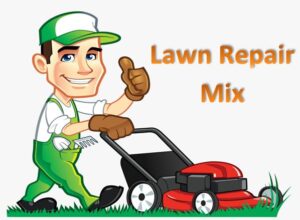
Top-dressing is the process of spreading a thin layer (no more than 1/2 inch thick) of organic material on top of your lawn to amend your soil. Top-dressing is a proven way to restore a damaged lawn. You can top-dress your entire yard or focus on bare spots and combine it with overseeding. Top-dressing is the best way to rejuvenate your lawn without pulling up all your grass and starting over. As your grass grows through the layer of top-dressing, the organic material in the top-dressing is incorporated into the soil beneath it. Top-dressing adds nutrients and improves soil quality.
 Our Lawn Repair Mix blends the 3 top beneficial products your lawn needs most – and in the optimal percentages of 50% topsoil, 25% fine sand and 25 % Purple Cow Classic compost. (Purple Cow Classic Compost is 100% plant based, finely screened, manure, weed seed and pathogen free.)
Our Lawn Repair Mix blends the 3 top beneficial products your lawn needs most – and in the optimal percentages of 50% topsoil, 25% fine sand and 25 % Purple Cow Classic compost. (Purple Cow Classic Compost is 100% plant based, finely screened, manure, weed seed and pathogen free.)
Top-dress to a depth of no more than ½ inch to insure your existing lawn can work through the layer and see a positive change. Our rule of thumb is to use 1.5 cubic yards of top-dressing for every 1,000 square feet. Again, when you overseed before you spread your top-dressing, there’s no need to rake the grass seed into the mix.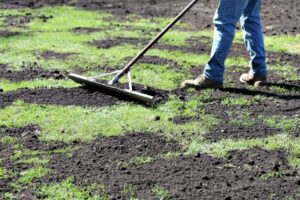
Use a tine, leaf rake or landscape rake or broom to spread and level the top-dressing material. Ensure that it fills any low spots or uneven areas. Be careful not to smother the grass. The blades should still be visible after the top-dressing is applied. The goal is to achieve even coverage and a smooth, uniform surface.
Step 4: Water, Water, Water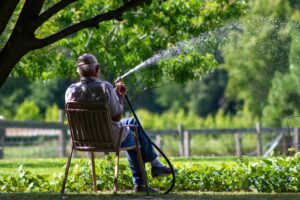
- After you have applied and leveled your top-dressing material, gently water your lawn to help settle the material into the soil.
- Watering also encourages the breakdown of the organic matter in the mix, which releases nutrients to the grassroots.
- Adjust your watering schedule and quantity as conditions dictate.
- Water the lawn daily to a depth of at least ½ inch if possible for the first few weeks.
- Don’t be surprised if you find some weeds popping up in your newly top-dressed lawn – it’s pretty much inevitable. You can pull them by hand as they appear, or wait until your lawn is tall enough to mow and then chemically spot treat the weeds with a spray product.
Summer dry spells can be hard on your lawn. Following these tips will help insure that your grass will not only survive, but improve. Call or stop by Tim Wallace Landscape Supply. Let’s talk about all your lawn repair, renovation and improvement needs. (630) 759-5552


